|
Home
Hataya
Sensei DVD
Search
Bushido
Respect for Katana
Sword Dictionary
How to Guides
Bow In Ceremony
Warm Up Exercises
Bow Out Ceremony
Wearing Uniform
Formal Uniform
Wearing Daisho
Uniform Folding/Care
Katana Selection
Sword Dimensions
Sword Testing
Katana Maintenance
Katana Cleaning
Mekugi Replacement
Katana Disassembly
Is my sword sharp?
Edge Geometry
Surface Polish
Sharpening Guide
Training Basics
Kihon (Fundamentals)
8 Basic Cuts
Toyama Kata
Toyama Kukmitachi
Seitei Kata
Taikai Guides
Taikai Rules
Judging Guide
Tameshigiri
Target Prep & Spiking
Cutting Patters
Cutting Videos
Target Comparison
St Petersburg Dojo
Intro Letter
Femal Sensei
Dojo Members
Code of Conduct
Classes and Fees
Promotion Pictues
Rank Testing
Links
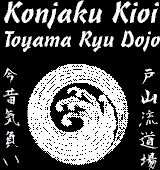
|
Tameshigiri 試し - Test Cutting
Tameshigiri teaches the student how to effectively strike with the sword.
This training is only performed after months of training because shinken
(real swords) are used. Tameshigiri is performed on
tatami omote
(Japanese straw floor covering) that has been rolled up and soaked in water
overnight. Target stands should 2 shaku (approximately 2 feet) high
with 5 bu (approximately 6 inch) spikes.
All cutting patterns can be reversed, but all cuts should be change from
migi (right) to hidari (left) and hidari (left) to migi (right) in the
sequence.
Please do not try tameshigiri without
proper instruction and supervision. We require months of classes before
students begin this type of training. Stainless steel replica swords are not
used since they can easily break and cause serious injury.
Beginning Tameshigiri Sequences
- Sayuw Kesa Giri
- Sayuw Kesa / Gyaku Kesa Giri
- Godan Giri
- Rokudan Giri
Intermediate Tameshigiri Sequences
- Futo Giri
- Yoko-Narabi
- Dodan
- Tsubame Gaeshi
- Inazuma Giri
- Gyaku-Inazuma Giri
- Nami Gaeshi
Advanced Tameshigiri Sequences
- Daruma otoshi
- Dow Barai
- Kasumi
- Kawasemi
- Makuri
- Mizu Gaeshi
- Mizu Guruma
- Nuki Uchi
- Syo Hatto
- Tombo
- Zengo-no-teki
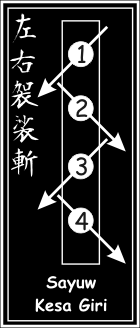
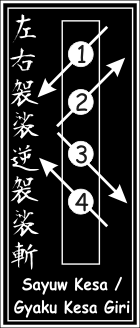
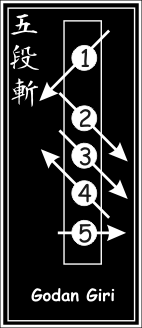
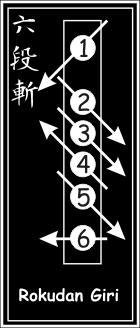
- Sayuw Kesa Giri:
Alternating Hidari Kesa (downward diagonal cut to the left) and Migi Kesa
(downward diagonal cut to the right). The forward foot is switched
after each cut.
- Sayuw Kesa / Gyaku Kesa Giri:
Hidari Kesa (downward diagonal cut to the left), gyaku kesa (upward
diagonal cut to the right), switch feet, Migi Kesa (downward diagonal cut
to the right), and gyaku kesa (upward diagonal cut to the left).
- Godan Giri: Five Cuts - Hidari Kesa (downward
diagonal cut to the left), switch feet, Migi Kesa (downward diagonal cut
to the right), Migi Kesa (downward diagonal cut to the right), and gyaku
kesa (upward diagonal cut to the left), and suihei (horizontal cut to the
right).
- Rokudan Giri: Six cuts - Hidari Kesa
(downward diagonal cut to the left), switch feet, Migi Kesa (downward
diagonal cut to the right), Migi Kesa (downward diagonal cut to the
right), and Gyaku kesa (upward diagonal cut to the left), Migi Kesa
(downward diagonal cut to the right), and Suihei (horizontal cut to the
left).
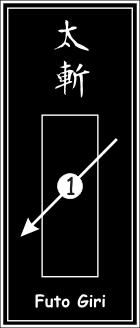
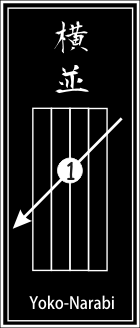
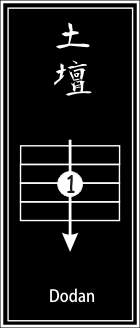
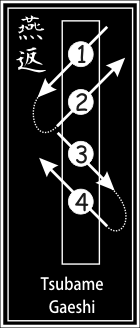
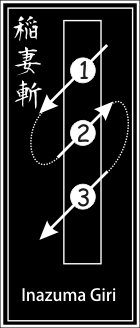
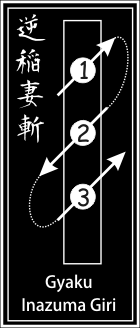
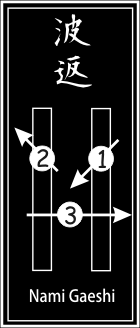
- Futo Giri:
Thick cut - Kesa giri (downward diagonal cut) on single large multi-roll target.
This usually ranges from 2 to 6 targets.
- Yoko-narabi:
Multiple targets lined up in a row cut with Kesa giri (downward diagonal cut).
This usually ranges from 2 to 6 targets.
- Dodan:
Execution Cut - Multiple horizontally stacked targets are cut with single
Gedon (Downward vertical cut). The top of a dodan cutting stand
should be soft wood since the katana may contact it. Competitions
usually use double targets.
- Tsubame Gaeshi:
Returning Swallow Cut - Hidari Kesa (downward diagonal cut to the left),
Gyaku kesa (upward diagonal cut to the right), switch feet, Migi Kesa
(downward diagonal cut to the right), and gyaku
kesa (upward diagonal cut to the left). The kesa and gyaku kesa are
done quickly with no pause between cuts.
- Inazuma Giri: Lightning cut - Hidari Kesa
(downward diagonal cut to the left), Gyaku kesa (upward diagonal cut to
the right), and Hidari Kesa (downward diagonal cut to the left).
This is a fast sequence of cuts with no pauses between them. All
cuts in the sequence must be completed within one second.
- Gyaku-Inazuma Giri: Reverse Lightning
cut - Migi Gyaku kesa (upward diagonal cut to the right), Hidari Kesa
(downward diagonal cut to the left), and Migi Gyaku kesa (upward diagonal
cut to the right). This is a fast sequence of cuts with no pauses
between them. All cuts in the sequence must be completed within one
second.
- Nami Gaeshi: Returning wave cut - This
sequence is done on two targets standing side by side. The targets
stands should be pushed together. Hidari Kesa (downward diagonal cut
to the left) on the right target, Hidari Gyaku kesa (upward diagonal cut
to the left) on the left target , and Suihei (horizontal cut to the
right) on both targets. The first cut must stop before impacting the
second target. The second cut is made without removing the katana
from between the targets. The first two cuts should be at the same
level.
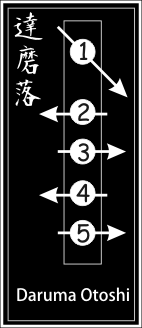
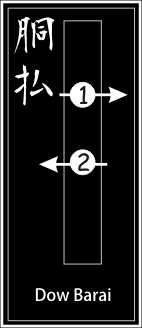
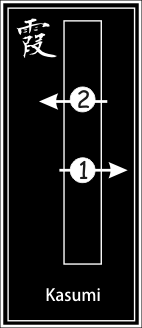
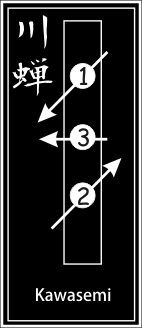
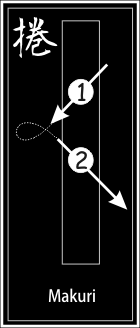
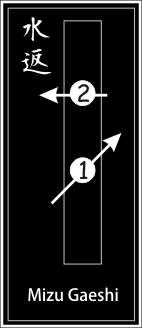
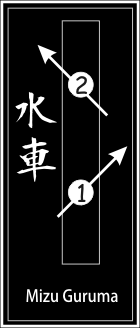
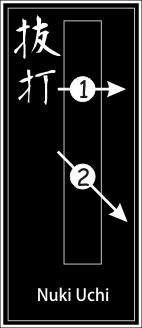
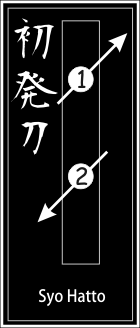
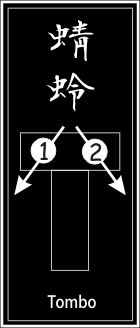
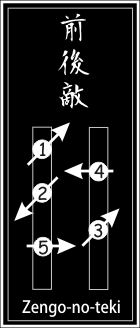
- Daruma otoshi:
Batto Migi Kesa (downward diagonal cut to the right made as the katana
leaves the saya) followed by four fast Suihei (horizontal cuts).
- Dow Barai:
Batto Suihei (horizontal cut to the right made as the katana leaves the
saya), followed by single handed Suihei (horizontal cut to the left)
- Kasumi:
Mist - Low Suihei (horizontal cut to the right) followed by high Suihei
(horizontal cut to the left). The second cut is made on the severed
section of the target before it falls.
- Kawasemi:
Kingfisher - Hidari Kesa (downward diagonal cut to the left), low Gyaku kesa
(upward diagonal cut to the right), and middle Suihei (horizontal cut to
the left). The third cut is made on the severed section of the
target before it falls.
- Makuri:
Wind - Hidari Kesa (downward diagonal cut to the left) from Hasso no Kamae
(guard position with the katana pointed upwards, the edge forward, and the
guard level with the ear), and Migi Kesa (downward diagonal cut to the
right). Both cuts are made quickly without a pause and should be
completed within one second.
- Mizu Gaeshi:
Returning Water - Low Gyaku kesa (upward diagonal cut to the right) and high
Suihei (horizontal cut to the left). The second cut is made on the
severed section of the target before it falls.
- Mizu Guruma:
Water wheel - Low Gyaku kesa (upward diagonal cut to the right) followed by high
Gyaku kesa (upward diagonal cut to the left). The second cut is made
on the severed section of the target before it falls.
- Nuki Uchi:
Batto Suihei (horizontal cut to the right made as the katana leaves the
saya) on the third step, change feet, Migi Kesa (downward diagonal cut to
the right). Similar to Toyama
Kata Sambon Mei.
- Syo Hatto: Batto Gyaku kesa (upward diagonal
cut to the right made as the katana leaves the saya) on the second step,
switch feet, Hidari Kesa (downward diagonal cut to the left).
Similar to Toyama Kata Nihon Mei.
- Tombo:
Dragon Fly - A half target is laid horizontally on top of a half target.
Hidari Kesa (downward diagonal cut to the left) from hasso gamae (guard position
with the katana pointed upwards, the edge forward, and the guard level
with the ear), and Migi Kesa (downward diagonal cut to the right) ending in hasso gamae.
The second cut must be performed before the target has a chance to fall.
- Zengo-no-teki:
Enemies to the front and back - This sequence is performed on two targets.
One is placed to the cutter's right and one is placed behind them. Turn and
Batto Gyaku kesa (upward diagonal cut to the right made as the katana
leaves the saya), Hidari Kesa (downward diagonal cut to the left), turn to
second target, Mizu Gaeshi (See description above), and
Suihei first target on return stroke.
|























